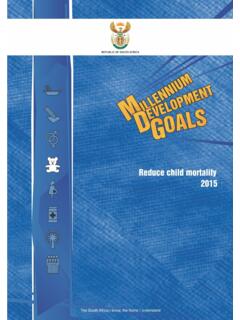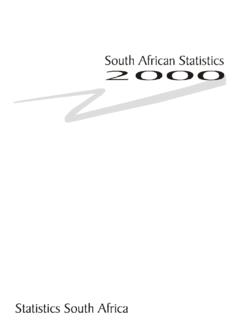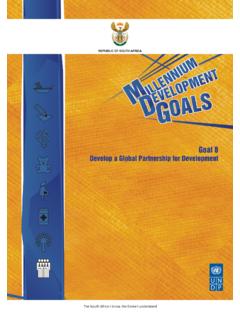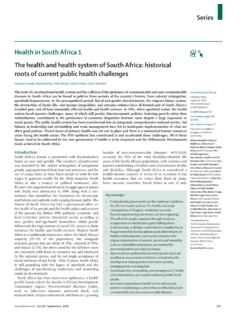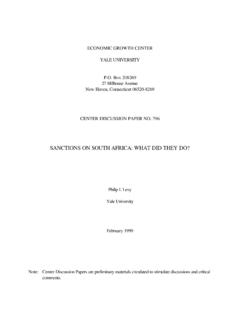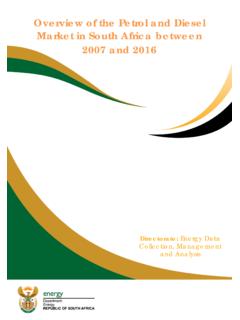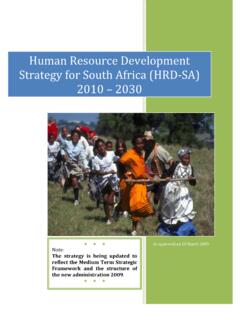Transcription of Employment, unemployment, skills and economic growth
1 Employment, unemployment, skills and economic growth An exploration of household survey evidence on skills development and unemployment between 1994 and 2014 Statistics south Africa Overview Exploration of skills within the south african workforce over the last 20 years, using data from: 1994: October Household Survey 2014: Quarterly Labour Force Survey Exploration of skills trends in terms of: Race Age The single most important investment any country can make is in its people. National Development Plan The south african economy (2003-2014) growth in GDP quarter-on-quarter (annualised) Recession First q/q contraction since 2009 Good times! 7,5% economic growth Currently slow economic conditions in global economy, but domestic factors as well. Is SA generating the skills necessary for economic development? Occupational composition of the three skill levels Skilled Managers Professionals Technicians Clerks Breakdown of skill level by occupation Domestic workers Sales & services Skilled agriculture Craft Machine operators Elementary Low-skilled Semi-skilled How has the south african workforce shifted in terms of these skill levels since 1994?
2 Trends in terms of race 02 0004 0006 0008 00010 00012 000 BlackAfricanColouredIndian /AsianWhite95% Number of workers in the labour force by race 45% 47% 9% ('000) 1994 2014 The highest growth was experienced in black african employment The proportion of black african workers in the labour force has also increased since 1994 1994 2014 How has the racial composition of each skill level changed? Within the skilled workforce , the proportions of all non-white race groups increased. However, to see a more complete picture of transformation, trends within race groups need to be explored Percentage of workers within each race group who are skilled (managers, professionals, technicians) by 3% points by 11% points by 26% points by 19% points Trends in terms of age 0%10%20%30%40%50%60%70%80%15-2425-3435-4 445-5455-6415-2425-3435-4445-5455-6415-2 425-3435-4445-5455-6415-2425-3435-4445-5 455-64 Black AfricanColouredIndianWhite1994 2014 Percentage of workers in each age group who are skilled (managers, professionals, technicians)
3 There were much weaker gains in the black african group for all ages 0%10%20%30%40%50%60%70%80%15-2425-3435-4 445-5455-6415-2425-3435-4445-5455-6415-2 425-3435-4445-5455-6415-2425-3435-4445-5 455-64 Black AfricanColouredIndianWhite1994 2014 The percentage of workers in skilled occupations increased in all age and all race groups, except for black Africans aged 25-34, which decreased Percentage of workers in each age group who are skilled (managers, professionals, technicians) What the data show in terms of skills Gains in skilled employment from 1994 to 2014 Gains in black african employment from 1994 to 2014 Across population groups, the proportion of black african , coloured, and Indian/Asian workers within the skilled workforce increased However, there was uneven distribution of progress within population groups. Within black african employment the growth in skills , as a proportion, was much lower than in the other population groups Within the black african 25-34 age group, the skilled proportion of employment decreased Unemployment The official unemployment rate for south Africa increased from 22% in 1994 to 25% in 2014 The expanded unemployment rate for south Africa was 35% in both 1994 and 2014 Labour market dynamics (1994 vs 2014) Number of individuals The number of employed has increased by 6,1 million since 1994.
4 The number of unemployed ( expanded definition) has increased by 3,4 million. The percentage growth of the unemployed (73,3%), however, has been higher than the growth of the employed (69,2%). Employed (000)8 89615 0556 15969,2 Unemployed (000)2 4895 0672 578103,4 Labour force (000)11 38620 1228 73676,7 Unemployment rate22%25%+3,3 % points-Unemployed (000)4 7078 1573 45073,3 Labour force (000)13 60323 2129 60970,6 Unemployment rate35%35%unchanged-Expanded19942014 ChangeChange (%)Strict01 0002 0003 0004 0005 0006 0007 0008 00019942014 Black african White Indian / Asian Coloured Number of unemployed and unemployment rates by race (1994 vs 2014) 43% 24% 17% 7% 40% 28% 18% 8% 0%5%10%15%20%25%30%35%40%45%1994rate2014 rateUnemployment rate Number of unemployed (000) The numbers of unemployed have increased for all race groups 01 0002 0003 0004 0005 0006 00019942014 Less than matric Tertiary Matric 40% 28% 6% 42% 34% 14% 0%5%10%15%20%25%30%35%40%45%19942014 Unemployment rate Number (000) Number of unemployed and unemployment rates by highest level of education (1994 vs 2014)
5 Unemployment has increased for all educational levels. The unemployment rate for those with tertiary qualifications has increased from 6% to 14% 0%5%10%15%20%25%30%35%40%45%50%199420141 99420141994201419942014 Black AfricanColouredIndian / AsianWhiteLess than matricMatricTertiaryUnemployment rates for individuals by highest education level and race The unemployment rate amongst black Africans who have a tertiary education has increased. However, the unemployment rate amongst black Africans with a matric has decreased. Index, Q1 2007 = 100; employment indices based on Quarterly Employment Statistics 8090100110120130 Mar/07 Mar/08 Mar/09 Mar/10 Mar/11 Mar/12 Mar/13 Mar/14 Real GDPM iningManufacturingConstructionTradeFinan ce and businessCommunity servicesEmployment growth has been below real GDP growth in most sectors Transition rates From one quarter to the next quarter, average for 2010 to 2013 Total11,24,3By highest education level: Primary14,05,7 Secondary not completed11,16,1 Secondary completed9,93,7 Tertiary12,11,2By age.
6 Youth10,26,4 Adult13,42,9 From unemployed to employed (%)From employment to unemployed or not economically active (%)Unemployment rate by age (2008-2014) Unemployment rate for the youth, by race (2008-2014) Discouraged work-seekers (percentage of working age) (2008-2014) Final remarks NDP sees skills development as critical SA has set itself the goals of eradicating poverty, reducing inequality, growing the economy by an average of 5,4%, and cutting the unemployment rate to 6% by 2030. Education, training and innovation are critical to the attainment of these goals (NDP: 296-7). NDP enabling milestone: ensure that skilled, technical, professional and managerial posts better reflect the country s racial, gender and disability makeup (NDP: 34) NDP critical action: an education accountability chain, with lines of responsibility from state to classroom (NDP: 34) Improving the quality of education outcomes throughout the education system [is] one of the highest priorities over the next 18 years, and beyond (NDP: 133) Inadequate education system findings from the NDP NDP chapter 9: Improving education, training and innovation SA faces a low growth , middle income trap, characterised by: Weak competition for goods and services High unemployment Low savings A POOR skills profile The quality of education for most black children is poor By the end of Grade 12, SA has lost HALF of every cohort entering the schooling system.
7 Which wastes human potential and harms life-chances of our youth Inadequate education system findings from the NDP The post-school system is not well designed to meet our skills development needs The performance of universities is uneven Further education and training (FET): too small, poor output, not effective (65% of college students unable to find work experience) Problems with sectoral education and training authorities (SETAs): Poor governance Inadequate human resources Poor management No proper monitoring and evaluation No accurate records of beneficiaries and impact No linkages with the post-school sector Why is our skills development not optimal? Apartheid legacy? Closure of teacher training colleges? Inappropriate merging of educational institutions? Outcomes-based education? Weak administration ( delivery of school books)? Firms not willing to invest in training of employees?
8 Other ( role of parents)? Conclusion The QLFS data strongly support the findings of the NDP that the education system is not adequately serving skills development, and is in urgent need of reform Weak GDP data since 2008 further support the NDP s findings that a broad programme of reform needs to be implemented, with skills development as one of its key features Employment growth between 1994 and 2014 was completely inadequate to reduce unemployment, further raising the level of urgency with which skills development should be treated Thank you



